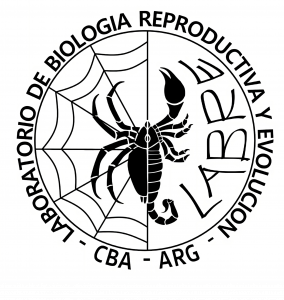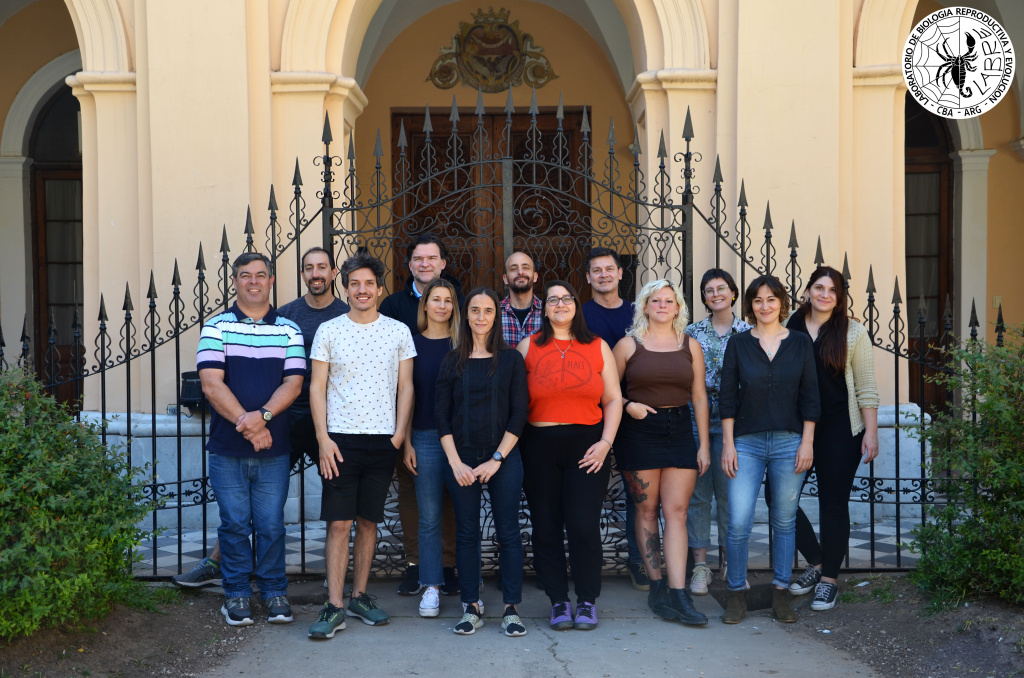 Somos un entusiasta grupo de investigadores, docentes, becarios y estudiantes enfocados en la biología reproductiva de los artrópodos, con énfasis en la evolución de los rasgos sexuales entre los arácnidos.
Somos un entusiasta grupo de investigadores, docentes, becarios y estudiantes enfocados en la biología reproductiva de los artrópodos, con énfasis en la evolución de los rasgos sexuales entre los arácnidos.
Iniciamos este camino hace 10 años para ofrecer un lugar de investigación y docencia en nuestro país en esta apasionante temática. Junto con estudios de biodiversidad y filogenia, queremos mostrar una perspectiva integrada de los arácnidos.
Líneas de investigación
- Estudio comparado y experimental de patrones y mecanismos de selección sexual
- Biodiversidad y filogenia de grupos seleccionados de arácnidos
- Exploración de la fenología y ecología reproductiva
- Divulgación de nuestro conocimiento científico mediante publicaciones y docencia
Sitio web
- www.labre.com.ar
- Perfil en Instagram
Investigadores
Dr. Alfredo Vicente Peretti
Investigador Principal CONICET
Contacto: aperettibec@gmail.com
Dr. Camilo Iván Mattoni
Investigador Independiente CONICET
Contacto: camilomattoni@gmail.com
Dra. Lucia Calbacho-Rosa
Investigadora Adjunta CONICET
Contacto: luciacalbacho@gmail.com
Dr. David Vrech
Investigador Adjunto CONICET
Contacto: dvrech@gmail.com
Dr. Matias Izquierdo
Investigador Adjunto CONICET
Contacto: matias_iz@outlook.com
Dra. Paola Olivero
Investigadora Asistente CONICET
Contacto: paoolivero@gmail.com
Becarios posdoctorales
Dr. Franco Cargnelutti
Becario posdoctoral CONICET
Dra. Fedra Bollati
Becaria posdoctoral CONICET
Dra. Mariela Oviedo
Becaria posdoctoral CONICET
Becarios doctorales
Biol. Rocio Palen Pietri
Becaria Doctoral CONICET
Biol. Catalina Simian
Becaria Doctoral CONICET
Biol. Julieta Giménez Carbonari
Becaria Doctoral FONCyT
Publicaciones (últimos 5 años)
- Cargnelutti F., Bollatti F., Izquierdo M. A., Abregú D., Oviedo-Diego M., Vrech D., Olivero P., Calbacho-Rosa L., Simian C., Palen-Pietri R., Mattoni C., Peretti A. V. 2023. Chapter Three – Waking beauties: Mating quiescence in arachnid females. Advances in the Study of Behavior, Vol 55: pp 55-159. https://doi.org/10.1016/bs.asb.2023.03.001
- Bollatti F., Aisenberg A., Toscano-Gadea C.A., Peretti A.V., González M.. 2023. Updates and perspectives on reproductive behavior of South American wolf spiders. The Journal of Arachnology, 51(1):63-79. https://doi.org/10.1636/JoA-S-21-059
- Huber, B. A., Meng, G., Král, J., Ávila Herrera, I. M., Izquierdo, M. A., & Carvalho, L. S. 2023. High and dry: integrative taxonomy of the Andean spider genus Nerudia (Araneae: Pholcidae). Zoological Journal of the Linnean Society, zlac100. https://doi.org/10.1093/zoolinnean/zlac100
- Huber B.A., Meng G., Acurio A. E., Astrin J. J., Inclán D. J., Izquierdo M. and Valdéz-Modragón A. 2022. Metagonia spiders of Galápagos: blind cave-dwellers and their epigean relatives (Araneae, Pholcidae). Invertebrate Systematics, Vol 36(7):647–678. https://doi.org/10.1071/IS21082
- Bollatti, F., Simian, C., Peretti, A. V., & Aisenberg, A. 2022. Challenging monogamy in a spider with nontraditional sexual behavior. Scientific Reports, Vol 12(1), 5948. https://doi.org/10.1038/s41598-022-09777-7
- Mardiné E, Peretti AV, Albín A, Oviedo-Diego MA & Aisenberg A. 2022. Size matters: Antagonistic effects of body size on courtship and digging in a wolf spider with non-traditional sex roles. Behavioural Processes, 194, 104547. https://doi.org/10.1016/j.beproc.2021.104547
- Cargnelutti, F., Calbacho-Rosa, L., Córdoba-Aguilar, A., & Peretti, A. V. 2022. Successive matings affect copulatory courtship but not sperm transfer in a spider model. Biological Journal of the Linnean Society, Vol 135(2), 299-309. https://doi.org/10.1093/biolinnean/blab157
- Castillo-Pérez, E. U., Cargnelutti, F., Reyes-Ramírez, A., Rocha-Ortega, M., & Córdoba-Aguilar, A. 2022. When is a male too hot? Fitness outcomes when mating with high temperature, sick males. Journal of Thermal Biology, Vol 105, 103222. https://doi.org/10.1016/j.jtherbio.2022.103222
- Cargnelutti, F., Bollatti, F., Izquierdo, M. A., Castanheira, P. D. S., Baptista, R. L. C., Barrantes, G., & Aisenberg, A. 2022. Together but not intertwined: differences in sexual behavior between two sympatric and synchronic spider species, including one new synonymy (Araneae: Tetragnathidae: Tetragnatha). The Journal of Arachnology, Vol 50(1), 67-80. https://doi.org/10.1636/JoA-S-21-006
- Abregú D.A., Simian C., Mattoni C. I., Peretti A.V. 2022. Sexual behavior of Metaltella iheringi(Keyserling, 1891) (Araneae: Desidae): sexual patterns, female quiescence and comparisons with other spiders. The Journal of Arachnology, Vol 50(1): pp 81-89. https://doi.org/10.1636/JoA-S-20-045
- Oviedo-Diego MA, Costa-Schmidt LE, Mattoni CI & Peretti AV. 2021. Interaction between sexual communication functions leads to reproductive interference in two syntopic scorpion species. Animal Behavior, Vol 181, pp 83-93. https://doi.org/10.1016/j.anbehav.2021.08.029
- Garcia CF, Oviedo-Diego M, Laino A, Peterson G, Mattoni CI, Peretti AV & Ojanguren-Affilastro AA. 2021. Low temperatures induce physiological changes in lipids, fatty acids and hydrocarbons, in two rare winter scorpions of genus Urophonius (Scorpiones, Bothriuridae). Journal of Thermal Biology, Vol 96, 102841. https://doi.org/10.1016/j.jtherbio.2021.102841
- Peretti, A. V., Vrech, D. E., & Hebets, E. A. 2021. Solifuge (camel spider) reproductive biology: an untapped taxon for exploring sexual selection. The Journal of Arachnology, Vol 49(3), pp 299-316. https://doi.org/10.1636/JoA-S-20-037
- Nava-Bolaños, A., Vrech, D. E., Peretti, A. V., & Córdoba-Aguilar, A. 2021. Argentinian odonates (dragonflies and damselflies): current and future distribution and discussion of their conservation. Journal of Threatened Taxa, Vol13(11), pp 19448-19465.
- Cargnelutti F, Calbacho-Rosa L, Peretti A.V. 2021. Genital movements are not restricted to spermatozoa transfer in a haplogyne spider. Ethology, Vol 127, pp 731-738. https://doi.org/10.1111/eth.13210
- Cargnelutti F, Reyes Ramírez A., Cristancho S., Sandoval-García I. A., Rocha-Ortega M., Calbacho-Rosa L., Palacino F., Córdoba-Aguilar A. 2021. Condition-dependent male copulatory courtship and its benefits for females. Ecology and Evolution, Vol 11 (14), pp 9848-9855. https://doi.org/10.1002/ece3.7815
- Albín A., Simó M., Cargnelutti F., Aisenberg A., Calbacho-Rosa L. 2020. Sex and burrowing behavior and their implications with lytic activity in the sand-dwelling spider Allocosa senex. The Science of Nature, Vol 107(5), pp 1-8. https://doi.org/10.1007/s00114-020-01700-2
- Izquierdo M.A. 2020. A teratologic spider with duplicated reproductive organs. The Journal of Arachnology. Vol 48, pp 343–345.
- Cargnelutti F., Calbacho-Rosa L., Uñates D., Costa-Schmidt L.E., Córdoba-Aguilar A., Peretti A.V. 2020. Copulatory behaviour increases sperm viability in female spiders.
- Oviedo‐Diego M. A., Mattoni C. I., Vrech D. E., Michalik P., Peretti A. V. 2020. The morphology of mating plugs and its formation in scorpions: Implications for intersexual participation. Journal of Morphology, 281(6), pp 620-635. https://doi.org/10.1002/jmor.21125
- Palen-Pietri R., Ceballos A., Peretti A.. 2019. Sexual dimorphism and patterns of sexual behavior in Lustrochernes argentinus (Pseudoscorpiones: Chernetidae)”. The Journal of Arachnology, Vol 47 (3), pp 344-350. https://doi.org/10.1636/0161-8202-47.3.344
- Abregú D.A., Peretti A. V., González M. 2019. Male performance and associated costs in successive sexual encounters in a polygynous web wolf spider. Acta Ethologica, Vol 22 (3), pp 175–186. https://link.springer.com/article/10.1007%2Fs10211-019-00323-9
- Avigliano E., Rosso J. J., Lijtmaer D., Ondarza P., Piacentini L., Izquierdo M., Cirigliano A., Romano G., Nuñez Bustos E., Porta A., Mabragaña E., Grassi E., Palermo J., Bukowski B., Tubaro P., Schenone N. 2019. Biodiversity and threats in non-protected areas: A multidisciplinary and multi-taxa approach focused on the Atlantic Forest. Heliyon, Vol 5 (8), pp 1-13. https://doi.org/10.1016/j.heliyon.2019.e02292
- Albín A., Bardier G., Peretti A. V, Simó M., Aisenberg A. 2019. A matter of choice: substrate preference by burrow-digging males of a sand-dwelling spider. Journal of Ehtology, Vol 37 (1), pp 13-20. https://doi.org/10.1007/s10164-018-0561-0
- Romero-Lebrón E., Oviedo-Diego M. A., Elias D., Vrech D. E., Peretti A. V. 2019. Effect of the mating plug on female chemical attractiveness and mating acceptance in a scorpion. Ethology, Vol 125 (4), pp 184-194. https://doi.org/10.1111/eth.12842
- González M., Costa F. G., Peretti A. V. 2019. Different levels of polyandry in two populations of the funnel-web wolf spider Aglaoctenus lagotisfrom South America. Journal of Ethology, Vol 37 (3), pp 325-333. https://doi.org/10.1007/s10164-019-00606-5
- De Simone G.A, Bollatti F., Aisenberg A., Peretti A.V. 2019. Previous experience and substrate matter: Plasticity in burrow digging in a South American wolf spider. Acta Oecologica, Vol 1oo, pp: 1-6. https://doi.org/10.1016/j.actao.2019.103465
- Calbacho-Rosa L., Cargnelutti F., Peretti A.V., and Costa-Schmidt L. E. 2019. Female secondary sexual traits in spiders: Adaptive interpretations of the sternum projection in the pholcid Holocnemus pluchei. Zoology, Vol 136, pp 1-8. https://doi.org/10.1016/j.zool.2019.125694
- Copperi M. S., Ferretti N., Peretti A. V. 2019. The role of silk in courtship and communication in mygalomorph spiders: Do males regulate their courtship in response to female mating status?. Behavioural Processes,Vol 167, pp: 1-8. https://www.sciencedirect.com/science/article/pii/S0376635718304492?via%3Dihub
- Vrech D.E., Oviedo-Diego M.A., Olivero P.A., Peretti A.V. 2019. Successive matings produce opposite patterns on ejaculate volume and spermatozoa number in an ancient arthropod model with indirect sperm transfer. Cannadian Journal of Zoology, Vol 97 (7), pp 579-587, e-First Article. https://doi.org/10.1139/cjz-2018-0179
- Cargnelutti F., Uñates D., Vrech D.E., Bollatti F., Calbacho-Rosa L., Córdoba-Aguilar A. and Peretti A.V. 2019. Sperm viability in spiders: a first approach using Holocnemus pluchei (Scopoli, 1763) (Synspermiata: Pholcidae). Journal of Arachnology Vol 47, pp 52–56. https://bioone.org/journals/The-Journal-of-Arachnology/volume-47/issue-1/0161-8202-47.1.52/Sperm-viability-in-spiders–a-first-approach-using-iHolocnemus/10.1636/0161-8202-47.1.52.short
- Calbacho‐Rosa L., Cargnelutti F., Córdoba‐Aguilar A., Peretti A.V. 2019. Consistency of females’ stridulatory behaviour during inter‐sexual interactions in spiders. Ethology, Vol 125 (8), pp 548-554. https://onlinelibrary.wiley.com/doi/full/10.1111/eth.12880
- Oviedo-Diego M. A., Mattoni C. I., Peretti A. V. 2019. Specificity of the female’s local cellula immune response in genital plug producing scorpion species. PLoS ONE, 14(2), pp 1-24. https://doi.org/10.1371/journal.pone.0208682
- Botero-Trujillo R., Ott R., Mattoni C. I., Nime M. F. and Ojanguren-Affilastro A. A. 2019. Two new species of the sun-spider genus Gauchafrom Argentina and Brazil (Solifugae, Mummuciidae). Zootaxa, Vol 4551 (2), pp 180-194. http://dx.doi.org/10.11646/zootaxa.4551.2.3
- Olivero P., Vrech D.E., Oviedo-Diego M.A., Mattoni C.I., Peretti A.V. 2019. Courtship performance as a function of body condition in an ‘ancient’ form of sperm transfer. Animal Biology,Vol 69, pp 33-46. https://doi.org/10.1163/15707563-00001041
Libros
- Peretti, A. V.; Aisenberg, A. Cryptic female choice in arthropods: patterns, mechanisms and prospects. Zurich: SPRINGER, 2015. p. 509. ISBN 978-3-319-17894-3.
Capítulos de libros
- Costa-Schmidt, L.E; Albo, M.J.; Bollatti, F.; Cargnelutti, F.; Calbacho-Rosa, L.; Copperi, S.; Ferreti, N.; Izquierdo, M.; Peretti, A.V. 2017. Sexual selection in neotropical spiders: examples from selected groups. En: Behaviour and Ecology of Spiders: Contributions from the neotropical region (Eds. Carmen Viera and Marcelo Gonzaga).Springer. Cham, pp 303-350.
- Calbacho-Rosa, L.; Peretti, A. V.; Aisenberg, A.. Copulatory and Post-copulatory Sexual Selection in Haplogyne Spiders, with Emphasis on Pholcidae and Oonopidae. Zurich: SPRINGER, 2015. p. 109-144. ISBN 978-3-319-17894-3.
Proyectos
- “Biología reproductiva de arácnidos”. Secretaría de Ciencia y Tecnología; Universidad Nacional de Córdoba.
- “Evolución en artrópodos: patrones y mecanismos de selección sexual en grupos de arácnidos e insectos”. Fondo para la Investigación Científica y Tecnológica; Agencia Nacional de Promoción Científica y Tecnológica; Ministerio de Ciencia, Tecnología e Innovación Productiva.
- Selección sexual en artrópodos: patrones y mecanismos en arácnidos”. Consejo Nacional de Investigaciones Científicas y Técnicas.













